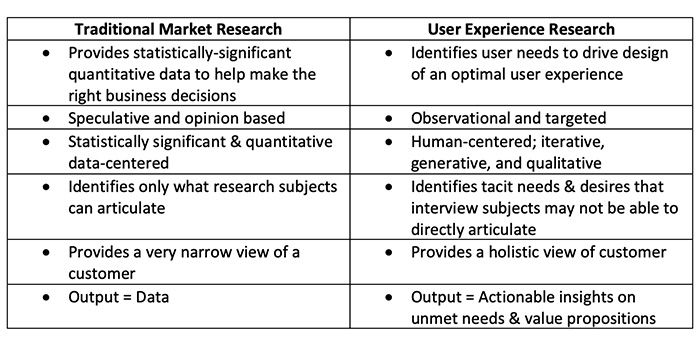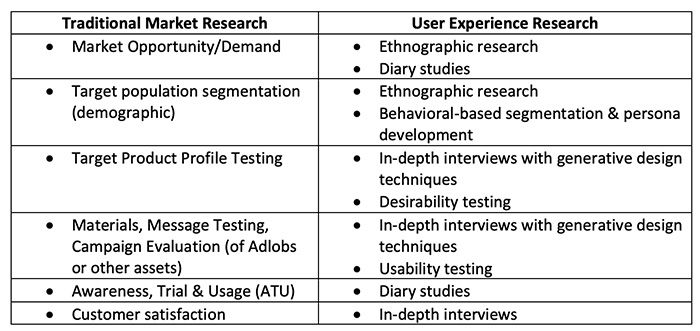Leveraging Market Research & User Experience Research in Life Sciences
The right market research insights provide a richer, more-nuanced picture of your customers as people, not just as numbers on a spreadsheet.
The COVID era has changed many things for life sciences companies. But it hasn’t changed the importance of patient centricity or the importance of fully understanding the needs of all of your key stakeholders across the treatment ecosystem. If anything, it’s now more essential than ever to develop a multi-dimensional view of your target audiences’ experiences to identify the right problems to solve for them as we navigate through this uncharted territory. But, if you’re depending on solely on traditional market research to accomplish this, you’re missing out on insights that provide a richer, more-nuanced picture of your customers as people, not just as numbers on a spreadsheet.
So how do you get this more human-centered view across such large audiences? By employing a research strategy that leverages both market research and user experience research. Each type of research provides valuable inputs, and combining them will not only help you better identify which critical audience challenges to solve, but will also help you develop truly innovative solutions.
And just what is the difference between these two types of research and how do they complement each other? Traditional market research has long been utilized in life sciences product development to inform critical business decisions. It provides valuable information about audiences’ wants in relation to the 4P’s of marketing — product, place, price, and promotion — and typically requires statistical significance because the business is making large, expensive, one-time product decisions. The insights it yields are particularly important in the early stages of drug development as the business attempts to discern what molecules they should develop, the target product profile, the market sizing, and their potential customer base.
But as well as traditional market research can inform the business on the market opportunity, it falls short of providing a rich, multi-faceted, human-centered view of the target audiences for several reasons:
• Traditional market research studies are narrowly focused and are designed to collect answers to specific questions to ensure statistical significance, leaving little room for spontaneous discovery and exploration. While user experience research applies a rigorous process, it is not designed to be statistically significant. It is observational with a flexible structure that fosters novel findings and allows time to explore them.
• Another limitation of traditional market research is that only identifies information that the interview subjects can articulate. User experience research can fill this gap by uncovering the audience’s tacit needs, the behavioral motivations and barriers which sit below the surface as well as the context, emotional triggers, barriers, and pain points that drive desires and behaviors.
• Traditional market research studies are finite with the study output as an endpoint. It does not close the loop between study output, solution development, and impact on target audiences. User experience studies are optimally part of a larger, iterative insights-driven process that includes research (learning), solution design, and follow-up with target users to evaluate solutions.
Some other key attributes of each type of research are as follows:

What’s the best mix of the two types of research?
The optimal mix of traditional market research and user experience research varies depending on what insights the business needs and what challenges it is working to solve. The chart below demonstrates how user experience research can enhance the some of the types of traditional market research commonly being employed during the various phases of drug development. This is not exhaustive, but rather an illustrative view of where your opportunities may be.

Comprehensive research in these unprecedented times
As the healthcare landscape continues to change as a result of Covid, a thorough understanding of your target audiences’ evolving needs and how you can meet them is more important than ever. Given that we are living through unprecedented events that we couldn’t have imagined just months ago, employing techniques that help uncover tacit user needs is critical because in the midst of crisis and uncertainty it can be even more challenging for study participants to identify and articulate their needs. The right combination of traditional market research and experience research will be the key to your success by providing you a holistic view of your audience(s) from which you can create the innovative solutions these circumstances require.
Tiffany Mura is VP Client Experience & Strategy, Health; Dan Berlin is SVP Experience Research; and Jen Briselli is SVP Experience Strategy & Service Design, all at Mad*Pow.
The Misinformation Maze: Navigating Public Health in the Digital Age
March 11th 2025Jennifer Butler, chief commercial officer of Pleio, discusses misinformation's threat to public health, where patients are turning for trustworthy health information, the industry's pivot to peer-to-patient strategies to educate patients, and more.
Navigating Distrust: Pharma in the Age of Social Media
February 18th 2025Ian Baer, Founder and CEO of Sooth, discusses how the growing distrust in social media will impact industry marketing strategies and the relationships between pharmaceutical companies and the patients they aim to serve. He also explains dark social, how to combat misinformation, closing the trust gap, and more.